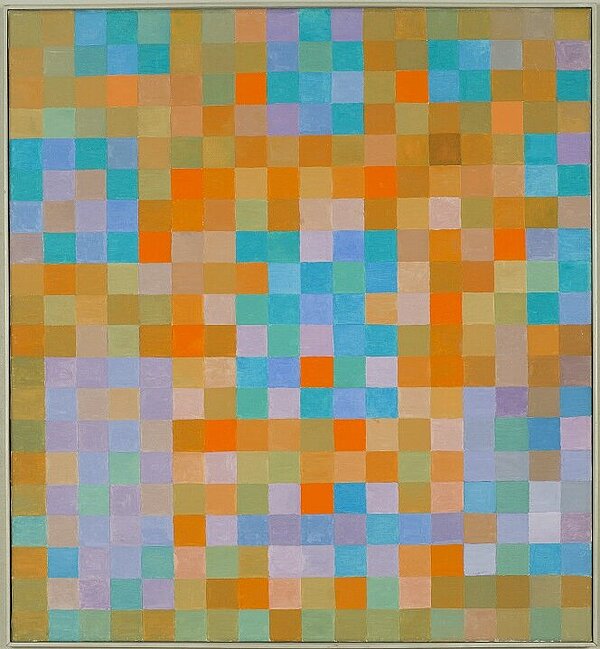Johannes Itten
Orange-Blaugrün-Modulation, 1964/65
[Orange-Bluish Green Modulation]
Oil on canvas
84 x 78 cm
© VG Bild-Kunst, Bonn 2025
Photo: Gerhard Sauer
The artist and art theorist Johannes Itten is above all known for his pedagogic work – in particular at the Bauhaus in Weimar – and for his colour theories. His artistic œuvre ranges from representational works to abstract geometrical structures based on grids and spirals, which he first created in 1915, to abstract sculptures and even to free, gestural compositions, which he did while he studied Japanese ink painting.
The preliminary course Itten devised for the Bauhaus influenced the whole of its teaching. Through the study of different materials, forms and colours, the students learned the rudiments of visual art. Since in his opinion corrections were deleterious to the students’ imagination and self-esteem, Itten had their works discussed collectively. He aspired to a holistic form of education for the whole person, so as to draw out their creative energies and develop their faculties of perception. For which reason the teaching – which included gymnastics, breathing and relax-ation exercises, meditation, and nutrition – encompassed the entire body, which had to be loosened up if the senses were to be trained and the ability to take in experiences increased. Itten took his direction from the teachings of the Mazdaznan movement, which were derived from the Zoroastrianism of ancient Persia along with other religions, and which around 1900 had many adherents from the “life reform” movement. Apart from this, he also received important inspiration from his teachers in Stuttgart, Adolf Hölzel and Ida Kerkovius, such as the idea of thinking in contrasts and starting with the colours when composing paintings. His teaching also came to include experimenting with materials and analysing historical artworks to explore rhythm, composition, and light and dark contrasts. Itten had taken a long look at the colour research done by among others Philipp Otto Runge, Johann Wolfgang von Goethe, and Adolf Hölzel, and in 1921 published his own colour scheme, the Colour Star, at the Bauhaus. The full sweep of his theories appeared later in 1961 in the publication Kunst der Farbe [The Art of Color, English 1973].
The oil painting Orange-Blaugrün-Modulation [Orange-Bluish Green Modulation] was done in 1964/65, a few years after Itten gave up his activities directing various schools and museums, and once again devoted himself to painting. He found the chessboard scheme to be liberating, for it released him from formal issues, and was an ideal way to study colour harmonies. The present painting brings together several of the colour contrasts Itten described: the cold-warm and light-dark contrasts, qualitative con trasts using tints mixed with white, and the exciting complementary contrasts between brilliant blue and orange. When brought together, these produce colour nuances that veer towards violet, ochre and olive green. The modulation from one tone to the next does not occur on the pic ture surface but in the eye of the beholder, which sees the squares as a whole. The contrasting colour fields produce an impres sion of flickering. (Marjatta Hölz)
Johannes Itten
1888 born in Süderen-Linden (CH)
1967 died in Zurich


